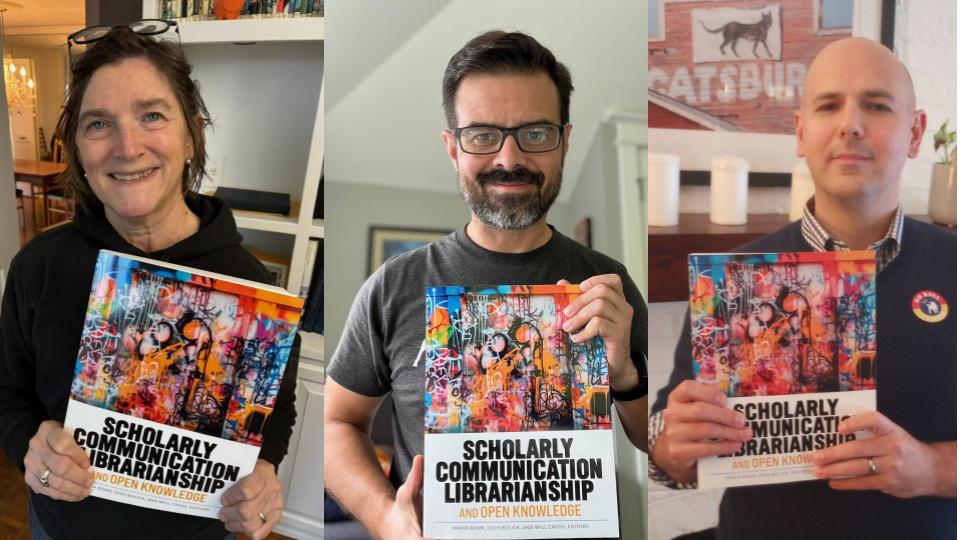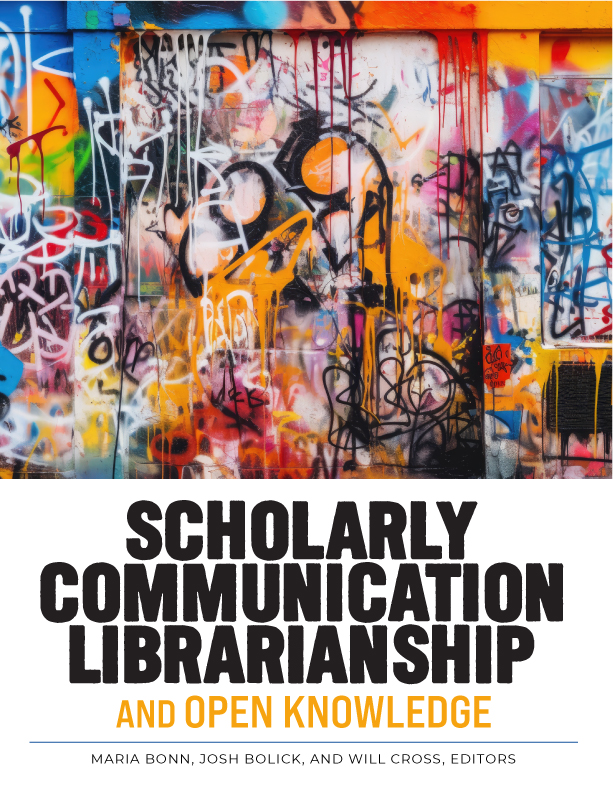It’s been a while! We’re still here and still in the thick of the work of scholarly communication librarianship. Way back in October of 2023, we shared that Scholarly Communication Librarianship and Open Knowledge, the book that began and underpins our collaboration, hit the streets and the shelves…er, the repositories and websites? The open edition was live on the ALA Store and in the ACRL Open Access Books site, where it still lives, and print copies were for sale (by our own choice, we receive no revenue from print sales).
We also told you that “for now, we are trying to take it a bit slower, savor reaching this point, and reflect on lessons learned so far. We also have ideas for moving forward and building on the work so far . . .” We have, indeed, savored the completion of the book and, for now, the completion of the work of The Scholarly Communication Notebook (SCN), and we have savored the continuing connections with so many smart and valued colleagues that the book helped us to establish, nurture and sustain.
As our friends in publishing, particularly book publishing, know, publishers have a practice of a “birthday party” – a meeting to review the performance, in terms of both sales and impact, around the first anniversary of a book’s publication. We’re a little late, but we wanted to have our own little birthday party for Scholarly Communication Librarianship and Open Knowledge.
We checked in with our publisher, ACRL, and asked our wonderful editor, Erin Nevius, how things look from her perspective. She enthusiastically reported “everything looks good from our seats! You’ve sold 146 copies of the print book and it’s likely to reprint in early 2025, which is really exciting. For an open access book or any book, that’s right when we want to see it needed.” Sadly, we lost quite a bit of the click data on the OA edition, but Erin is confident that “it’s many thousands by now.”
It’s been exciting to see our book generate reviews from our colleagues in the field. In The Journal of Scholarly Communication Librarianship Jonathan Grunert says that the book is a bit of a tome (this is sort of a, ahem, theme throughout the reviews) and praises its attention to scholarly communication issues. We are especially pleased that he calls out our “deft” assembly of contributors”, because bringing those contributors together feels like our greatest accomplishment in creating the book. Most heartwarming of all is that Grunert notes “what is most impressive about the book is the extent to which the editors ensure that the volume practices the values it contains.” Doing just that is an important personal and professional value for us, and we’re so glad that someone noticed.
Mahrya Burnett, in her review in College and Research Libraries, observes that the book “provides both the contextual information, and the practical skills and resources necessary for a deep, multi-faceted understanding of scholcomm and all it entails.” Burnett also notes that authors (we believe throughout, not just us) “have written about complex topics in a conversational and engaging manner, avoiding the terminology soup that can sometimes plague writing about scholcomm.” Alongside building an amazing group of contributors and striving to walk our talk, these are goals we applied ourselves to.
Another reviewer, Brad Eden, in his (paywalled, unfortunately) review in The Journal of Web Librarianship took exception with one place where we interjected our values into our discussion. In the introductory section we have a playful discussion of the difficulty of assigning first authorship to such a highly collaborative work. He declares it “silly.” We’d stick to our guns on this one: we need to recognize the tensions in an environment where first authorship is the coin of the realm and collaboration is essential. We’re grateful for the reviewer’s careful reading and that they found the book to have “many great ideas and content.”
Roxanne Missingham weighed in from The Journal of the Australian Library and Information Association (also paywalled, unfortunately). Roxanne warns that the book is “not a light read.” Boy howdy, do we know! Our many contributors had so many smart things to say on so many important topics that keeping the page count low would have been quite a challenge. We welcome that the review says “if you are new to scholcomm you will get an overview” and appropriately cautions “albeit from an unashamedly US perspective.” As we continue our work, we would love to cross more borders and expand to a more global perspective. We are thrilled that the reviewer calls our book “a genuinely fascinating experiment in scholarly writing.” One of the reasons an open license is valuable is the possibility of customizing to local context, though that requires someone to take it on. Admittedly, no small task.
Even better, Kayla Del Biondo, in a review in Library Resources and Technical Services says that we “wonderfully humanize the scholarly publishing landscape and open science movement.” This is high praise, and that praise must be shared with our contributors who are the ones that add those human voices to our book. Biondo concludes that the book is “fun and captivating!” We’ve known all along that scholarly communication librarianship is fun (it is, right?). We’re glad we can convince others likewise!
The reviews are very gratifying. People are reading our book! They have opinions!! Just as exciting has been the interest it has generated in the field. The book is a work of scholarship, but our intent has always been to reach, teach and support practitioners; both people currently working in scholarly communication and those who might do so.
The publication of the book, and the attention it has drawn, led to two wonderful opportunities to connect with our community. We partnered with SPARC this past late summer – early fall on the OA101 Series: Foundations for OA Work in a Rapidly Evolving Landscape. Four sessions were provided: OA Basics, OA Case Studies, Emerging Issues in OA, and Frequently Asked Questions re: OA. Each session had 800-1000 registrants and 300-400 attendees, and the recordings (linked from series page) have hundreds of views. The idea for the series emerged in conversations with Nick Shockey, who contacted us because SPARC was hearing from library deans and directors that they had a need for training that isn’t currently being met. We think the positive response in terms of attendance and feedback confirms that need. It was great to be given a chance to help meet it. We’re presently talking with SPARC about future offerings in this series and will share info about that when we know it.
We were delighted when the Scholarly Communication Caucus of the Medical Library Association reached out to tell us they had chosen Scholarly Communication Librarianship and Open Knowledge as the text for their fall reading group. While we wrote to be accessible for a generalist audience, it was wonderful to see specialists in one field engaging with the book to learn more about scholarly communication in their own work. Throughout the fall, we joined dozens of the caucus members online for five engaging sessions coordinated by Karen Gutzman, Yingting Zhang, and Kim Powell. We hope the participants came away with a deeper sense of many issues at play in scholarly communication. We certainly learned a lot about their experiences and perspectives.
We’ve also gotten occasional kind words of appreciation from colleagues in the field. One librarian wrote to tell us “I’ve recommended that opening portion of your book to several of my more junior colleagues as the essential primer on scholarly communication.” Since this was EXACTLY the role we hope the book will serve, this may be the best review of all.
We think the print book is very handsome, and the content is relevant and important. But it’s still two dimensional (as books and pdfs tend to be). There are more pictures, videos, recordings, charts and graphs that would make the content so much richer, and, we hope, more engaging. We’ve always talked about developing a full digital edition that takes advantage of the affordances of online delivery. It’s about time that we did more than talk. So, in the coming year, we’re planning on turning our attention to that digital edition. We’d love to hear ideas for ways to make it both educational and engaging.
If you have been a part of our work, or learned from it, critiqued it, and/or read this far, we appreciate you. In the midst of a lot of fear and uncertainty, we hope you’re hanging in there.
Maria, Will, and Josh


